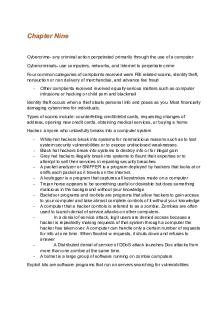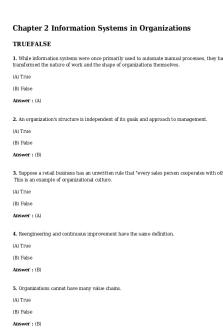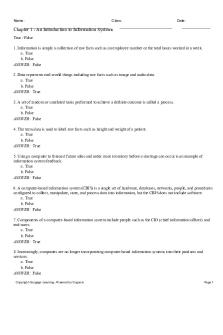Introduction to Computer Information Systems- Chapter 11 PDF

| Title | Introduction to Computer Information Systems- Chapter 11 |
|---|---|
| Author | Becca Klap |
| Course | Introduction to Computer Information Systems |
| Institution | Grand Rapids Community College |
| Pages | 4 |
| File Size | 56.5 KB |
| File Type | |
| Total Downloads | 29 |
| Total Views | 168 |
Summary
CIS/CO 100- Introduction to Computer Information Systems- MyLab Chapter Summaries
GRCC Pearson MyLab Technology in Action ...
Description
Chapter Eleven Databases can prevent the following problems with lists: data redundancy, data inconsistency (different versions of the same data appear in different places), with a list there are few checks to make sure that data entered is valid (inappropriate data), and incomplete data - databases manage large amounts of data efficiently, enable information sharing, and promote data integrity. Large amounts of data re complex and should be organized in specific ways for efficiency. With a database, one file is maintained and it provides data centralization. Data integrity means the data is accurate and reliable. Data centralization goes a long way toward ensuring data integrity. The process to ensure data is organized most efficiently is called data normalization. Relational databases operate by organizing data into various tables based on logical groupings. In these a link between tables that defines how the data is related is referred to as a relationship. The common field is one table is linked to the common field in another table. There are three types of relationships that an be created: one to many, one to one, many to many. An object-oriented database stories data in objects rather than in tables. Objects contain not only data but also methods for processing or manipulating that data. This allows them to store more types of data than relational databases and to access that data faster. They are also better at handling unstructured data. Data of this type is known as a binary large object BLOB because its encoded in binary form. A query language is designed to manipulate or extract data from a database. A multidimensional database stores data that can be analyzed from different perspectives, called dimensions. This distinguishes it from a relational database which stores data in tables that have only two dimensions- fields and records. Multidimensional databases organize data in a cube format. Each data cube has a measure attribute, which is the main type of data that the cube is tracking. Other elements of the cube are known as feature attributes, which describe the measure attribute in some meaningful way. -advantages: can be customized to provide info to a variety of users based on their needs. They can process data much faster than pure relational databases can. Data is stored in a database in: fields (categories into which a database organizes data), records (a group of related fields), tables (a group of related records organized into fields and records), -
Forms- to view, input or edit records individually Queries- questions to generate info Reports- summarized info
Data (field) types indicate what kind of data stored in the field. The following are the available field type: short text, long text, number and currency, data/time, yes/no, calculated, OLE object, hyperlink -
Create table in design view. Enter new data using datasheet view
Field properties help to define field data. Three common field properties are: field size (defines max number of characters a field can hold), the default value is what is used unless the user enters another value, a caption enables you to display the field name in a more meaningful or readable manner. -
-
Table relationships join tables together so queries can work with fields from more than one table. Table relationships help with form and report structure, and help protect against having unrelated records Simple query wizard- display a subset of records that match specific criteria, limit display of fields but not limit display of records Query design- combine fields from related tables, display specific records matching query criteria Filter by form- filter records by using criteria in one or more fields
When creating a table the use of primary keys is very important. A primary key is a field in the table which uniquely identifies a record. In related tables, the common field which is linked to a primary key in a one table is called the foreign key in the linked table. Referential integrity ensures that relationships between tables remain constant and guarantees the quality of the data in the database. Its useful, especially for large databases, to access the data dictionary (or the database schema). The attributes that define the data in the data dictionary are metadata (data that describes other data) Input forms are used to control how new data is entered into a database. Data validation is the process of ensuring that data entered into a field meets specified guidelines. A range check ensures that the data entered into the field falls within a certain range of values. A field constraint is a property that must be satisfied for an entry to be accepted into the field. A completeness check ensures that all required fields have been completed. A consistency check compares the values of data in two or more fields to see if those values are reasonable. An alphabetic check confirms that only textual characters are entered in a field. A numeric check confirms that only numbers are entered in the field. Displaying the tables on-screen and browsing through all the data is an option with most databases. You can easily sort data into ascending or descending order. There are two ways to display only those records that match particular criteria: use a filter, use a query. The most common form of output for any database is a viewable (or printable) electronic report. SQL uses relational algebra to extract data from databases. A data warehouse is a large scale collection of data that contains and organizes all the data from an organizations multiple databases in one place. Individual databases
contain a wealth of info, but each database’s info usually pertains to one area in the organization. Data warehouses, therefore, consolidate info from various operational systems to present an enterprise-wide view of business operations. Data in the data warehouse is organized by subject. Time-variant data means it pertains to more than one time period. Sources of data include: internal source, external sources, and clickstream data. Data staging steps are: extraction of the data, transformation (reformatting) of data, and storage of data. Data mining is the process by which data are analyzed and investigated, trying to spot patterns and trends. The techniques used are: classification, estimation, affinity grouping, clustering, and description and visualization. An info system is a software-based solution used to gather and analyze info. Databases, data warehouses, and data marts are integral parts of information systems because they store the info that make info systems functional. All info systems perform similar functions, including acquiring data, and providing the user with a number of output options with which to make the info meaningful and useful. Transaction-processing system (TPS) tracks everyday business transactions. Real-time processing ensures that the data is current, and batch processing is appropriate for activities that aren’t time sensitive. A management info system (MIS) provides timely and accurate info that enables managers to make critical business decisions. MISs were a direct outgrowth of TPSs. Managers realized that the data could be a powerful tool if the info could be organized and outputted in a useful form. Todays MISs are often included as a feature of TPSs. MISs generate three types of reports: a detail, summary, and exception reports. A decision support system is another type of business intelligence system designed to help managers develop solutions for specific problems. A DSS might provide statistical info on customer attributes, such as income levels or buying patterns, that would assists managers in making advertising strategy decisions. A DSS not only uses data from databases and data warehouses, it also enables users to add their own insights and experiences and apply them to the solution. A model management system assists in building management models in DSS. Financial and statistical analysis. A knowledge based system: provides intelligence that supplements the users own intellect. Natural language processing NLP system enables users to communicate with computer systems using a natural spoken or written language. Artificial intelligence is the branch of computer science that deals with the attempt to create computers that think like humans. Fuzzy logic enables the interjection of experiential learning into the equation by considering probabilities. Business intelligence (BI) is the ability to improve business decision making with databases. It is used to analyze and interpret large set of data, and enables execs and
senior managers to make informed decisions. An enterprise resource planning ERP system accumulates all info relevant to running a business. Power BI- free set of tools used to analyze data from a variety of sources. Reports, dashboards, visuals, can be updated real time, cloud-based component. Three elements: desktop app, web-based service, and mobile apps. Basic components: visualizations (charts, graphs, maps), tiles (single visualizations in report or dashboard), reports (collections of visualizations), dashboards (collections of visualizations on one page or canvas), datasets To help analyze and visualize data: natural language queries (plain English, additional suggested queries), quick insights (AI, interesting data patterns, confirm what u know), visual interactions, share them with others...
Similar Free PDFs

Chapter 11 - Information Systems
- 26 Pages

INTRODUCTION TO COMPUTER HARDWARE
- 39 Pages

Introduction to Sensory Systems
- 4 Pages

Introduction to Digital Systems
- 222 Pages
Popular Institutions
- Tinajero National High School - Annex
- Politeknik Caltex Riau
- Yokohama City University
- SGT University
- University of Al-Qadisiyah
- Divine Word College of Vigan
- Techniek College Rotterdam
- Universidade de Santiago
- Universiti Teknologi MARA Cawangan Johor Kampus Pasir Gudang
- Poltekkes Kemenkes Yogyakarta
- Baguio City National High School
- Colegio san marcos
- preparatoria uno
- Centro de Bachillerato Tecnológico Industrial y de Servicios No. 107
- Dalian Maritime University
- Quang Trung Secondary School
- Colegio Tecnológico en Informática
- Corporación Regional de Educación Superior
- Grupo CEDVA
- Dar Al Uloom University
- Centro de Estudios Preuniversitarios de la Universidad Nacional de Ingeniería
- 上智大学
- Aakash International School, Nuna Majara
- San Felipe Neri Catholic School
- Kang Chiao International School - New Taipei City
- Misamis Occidental National High School
- Institución Educativa Escuela Normal Juan Ladrilleros
- Kolehiyo ng Pantukan
- Batanes State College
- Instituto Continental
- Sekolah Menengah Kejuruan Kesehatan Kaltara (Tarakan)
- Colegio de La Inmaculada Concepcion - Cebu







![OBrien - Introduction to Information Systems [2010]](https://pdfedu.com/img/crop/172x258/zx28ke2j06rw.jpg)



